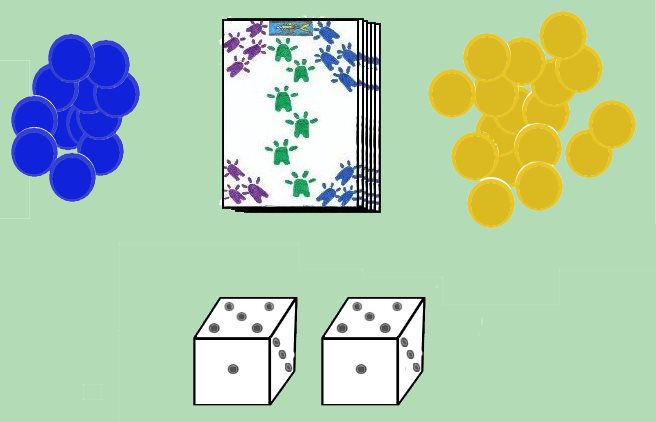 Dueling Nobles is a newer game
which is designed for two players and which plays very much like many
Collectible Card Games (CCG). Dueling Nobles was created by Jesse Carlucci and definitely plays differently than
most any other card game using a standard deck of cards.
Dueling Nobles is a newer game
which is designed for two players and which plays very much like many
Collectible Card Games (CCG). Dueling Nobles was created by Jesse Carlucci and definitely plays differently than
most any other card game using a standard deck of cards.
The game uses one standard 52 card deck as well as 2 standard dice (6-sided) as well as a number of chips or counters. These chips should be in two colors, one color of chip used to represent the current Stamina level of each Noble and the other color of chip used to indicate a player's current Resource total. It is recommended to have 12 such counters of one color (for the Stamina levels) and a second collection of approximately 24 counters to represent the Resource levels. Other mechanisms could also be used to record these numbers such as pencil and paper, however using chips or counters is usually preferred as it is easy and convenient.
To begin the deck should be divided into two stacks. One stack includes all the Jacks, Queens and Kings from the standard deck (called the Nobles deck) and the second stack includes all other cards (Ace, 2, 3, 4, 5, 6, 7, 8, 9, 10), called the Support card deck.
Each player should sit directly across the table from his opponent and will create a layout or play area in front of himself as the game progress. Determination of the dealer can be done in a number of ways, with a common method to have each player rolling both dice. The player who rolls the lowest total becomes the first dealer. If both players both roll the same total, they should each roll again. If multiple games are to be played, the role of dealer should, for each subsequent game, alternate amongst the two players.
To begin the game, the dealer deals 6 cards to each player from the Nobles deck. He deals these cards one by one, face down and starting with his opponent. Each player then looks at these cards and selects three of these cards and places them face-up in a special area in front of himself called his Courtyard. These are his Nobles. A player may select any combination of three cards from these cards to begin in his Courtyard. The remaining three Nobles unselected by each player are then all shuffled together and placed to the side in a face-down stack for later use.
The dealer then distributes six cards to each player from the Support deck, also one-by-one and face-down starting with his opponent. The pile of counters representing Stamina and Gold should also be placed near the center of the table in easy reach of both players.
Each Noble type (Jack, Queen or King) has different characteristics, so players will want to choose carefully from the Noble cards of which they are originally dealt. The following describes the characteristics and special abilities of each of the Noble types:
| Noble Card | Base Strength | Stamina | Special Abilities |
|---|---|---|---|
| King | 13 | 3 | Leadership - The King Noble, in a duel is entitled to roll two dice instead of one for his strength modifier during a duel. In addition, a King noble may elect, during the Income phase to be Taxed, subtracting one current Stamina point which earns the player one Resource. |
| Queen | 12 | 2 | Inspiration - The Queen Noble is entitled to add 3 points to her Base Strength for each other Noble currently in that player's Courtyard. |
| Jack | 11 | 2 | Bravery - The Jack Noble is entitled to play two Support cards instead of the usual limit of one such card for the other Noble types, to thus increase his Strength total during a duel. |
The players take alternating turns, starting with the dealer's opponent. Each turn is divided into four phases, which occur in a specific order. The following describes each of these phases.
Income: The first phase of each turn is called the Income phase. In this phase, the player can earn income in the form of Resource tokens. A player automatically earns one Resource at the beginning of this phase of his turn. He thus takes one of the Resource tokens from the center pile, and adds it to his own pile or treasury.
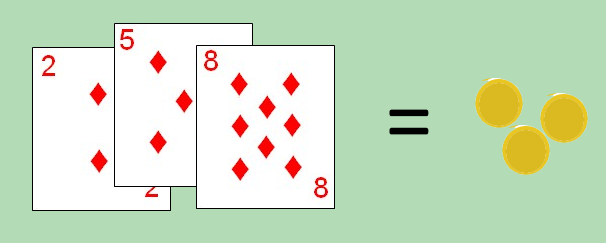 In addition to this automatic Resource gained at the beginning of the turn, there are a few other methods a player can earn additional resources during this phase of the turn:
In addition to this automatic Resource gained at the beginning of the turn, there are a few other methods a player can earn additional resources during this phase of the turn:
- If a player has three Support cards of the same suit in his hand he may discard these cards which then earns that player three additional Resources. These Resource tokens are taken from the central Resources pile and added to the player's personal treasury. The three discarded Support cards are placed face-down in a common Support card discard pile near the center of the table.
- If the player has a King Noble currently in his courtyard, this player may elect to have that King Noble from his own Courtyard subtract one point of his current Stamina which will then generate one additional Resource for the player. He may opt to do this for each King Noble that player has in his courtyard, at his option. However a player may never, in this manner, reduce one of his Noble's Stamina to zero.
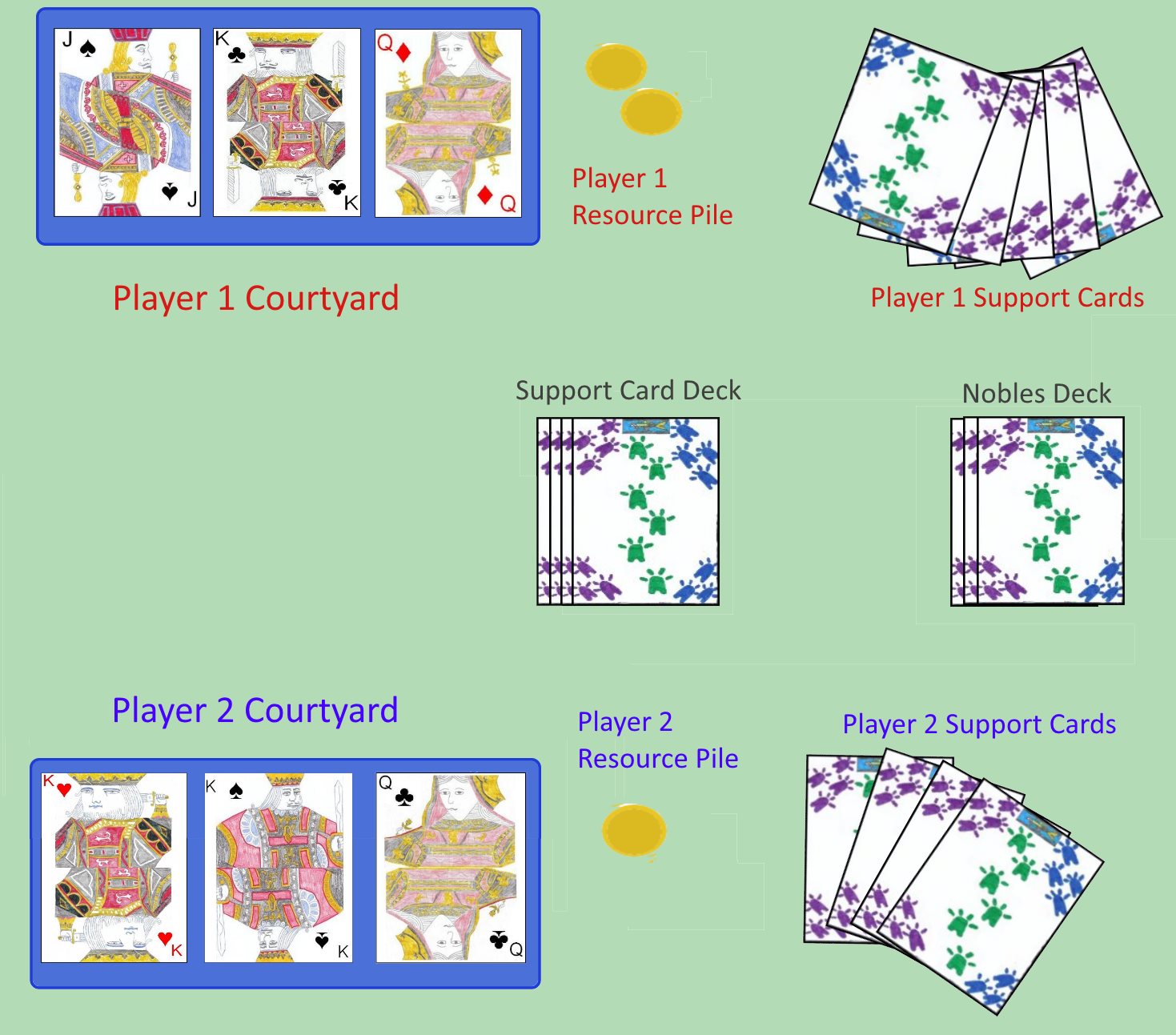 Reinforcements: The second phase of the turn is called the
Reinforcements phase. In this phase of his turn, a player has the
opportunity to possibly replace Nobles that have been previously
vanquished and/or draw new Support cards. Thus, during this phase, the
player can perform either, both or none of the following
optional actions:
Reinforcements: The second phase of the turn is called the
Reinforcements phase. In this phase of his turn, a player has the
opportunity to possibly replace Nobles that have been previously
vanquished and/or draw new Support cards. Thus, during this phase, the
player can perform either, both or none of the following
optional actions:
- At a cost of five Resources a player may draw the top card of the Noble stack and add the Noble
he draws from the stack to his Courtyard. There is no limit to the maximum number of Nobles a player may have in his Courtyard at any one time. However, if there are no cards remaining in the Nobles
stack, the player would not have the option to perform this action. The
appropriate Resource cost is removed from the player's personal treasury and
added back to the center Resources pile.
- Another action a player can take during the Reinforcement phase of the game is to buy new Support cards. Thus, a player is entitled to buy up to three support cards during this phase. He indicates how many he wants to buy (from 1 to 3) and then puts the appropriate number of Resources back into the center pile and draws the same number of new Support cards. He may only buy these cards once per turn, so the option to buy Support cards can only be performed once during this phase.
Command: The third phase of a player's turn is the Command phase. During the Command phase there are several actions a player can take:
- During this phase, a player can opt to add a Weapon to one of his Nobles. To do this, he plays any Support card from his hand which is of rank 2 or 3, on one of his Nobles. This card is a permanent Strength bonus to that Noble, and should be placed under the Noble and partially exposed to denote it is associated to that Noble. Any particular Noble can only have, at most, one such Weapon card associated to the Noble. A card of rank 2 adds two to the Base strength to the Noble and a card of rank 3 adds three to the Base strength of the Noble. A player can play only one new weapon card during his turn, however there is no limit to the total number of weapons cards a player can play over the course of an entire game, although as mentioned, any particular Noble can only have one Weapon card associated to that Noble.
- Also during this phase a player may move a Weapon from one of his Nobles to another, as long as the receiving Noble does not already have a Weapon associated. A player may move as many weapons as needed during this phase of the turn.
- The last action a player may take during the Command phase of the turn is the play of Suit Abilities. The effect of the card played will be dependent on the suit of the card played, the numerical ranking of a card played in this way is
irrelevant. After the card is played, it is added to the discard pile and the special effects are applied as indicated. A player may play multiple Suit Ability cards during this phase of the turn, but each Suit Ability (and a corresponding card played) may only be performed once per game per player. The following describes each of these Suit Abilities:
- Hearts: Playing a Support card in the suit of Hearts allows the player to restore 1 Stamina point to any one Noble currently found in the player's courtyard.
- Diamonds: Playing any Support card in the suit of Diamonds allows the player to draw 3 additional support cards from the support card stack into his own hand. However, this action may only be taken if the opponent currently has more total Nobles in his Courtyard than the player.
- Clubs: Playing any Support card in the suit of Clubs allows the player to take any one card from the exposed Support discard pile and add it into his hand.
- Spades: Playing a Support card in the suit of Spades allows a player to immediately view all cards in his opponent's current hand.
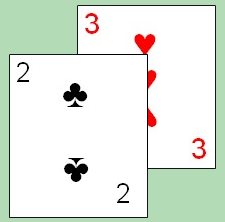
Dueling: The Dueling (or Battle) phase of the turn is when the player's Nobles can actually perform in duels against the opponent's Nobles. To declare a duel, the player selects one of the Nobles fron his Courtyard and any of his opponent's Nobles and indicates he wants to have a duel. The opponent has the option, upon the duel being declared to change which of his own Nobles is the target of the duel, by spending 2 Resources (this is called deflecting the duel). In doing so, the opponent can select any other Noble in his own courtyard to be the target of the duel instead of his Noble originally selected by the player who declared the duel.
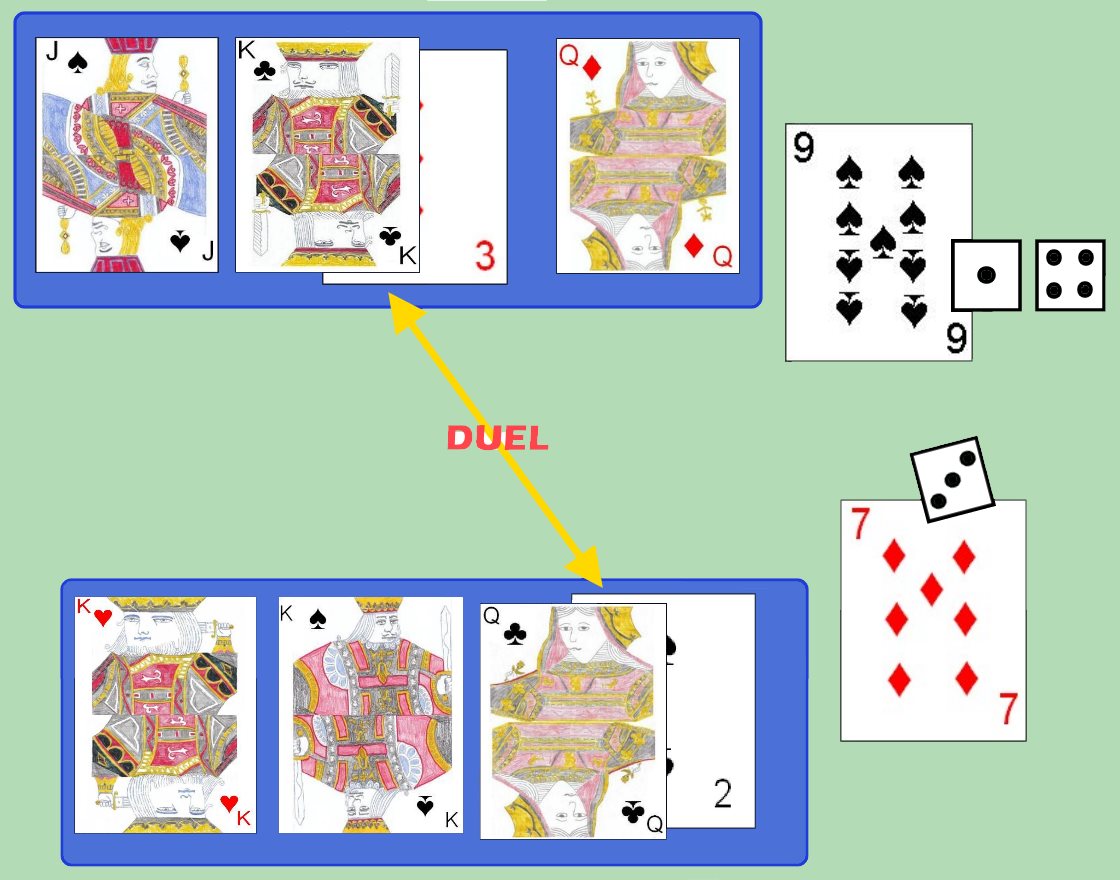 A duel itself is divided into multiple steps, as follows:
A duel itself is divided into multiple steps, as follows:
- Step 1: Each player should calculate the current strength of his Noble which is participating in the duel. He does this by adding the Strength value, as indicated for that particular Noble type, added to the value of any weapon which has been attached or associated with that Noble. In addition, and as indicated, certain Nobles (such as the Queen) have special abilities that allow them to add a Strength bonus, which should then also be added to the Noble at this time.
- Step 2: Each player then rolls one die (except the King, who, as one of his special abilities, is entitled to roll two such dice). The number rolled is then added to the total Strength of that Noble, as calculated in Step 1.
- Step 3: In the third step, each player, starting with the player who declared the duel, may optionally add support cards to assist his Noble in this duel. The player who initiated the duel must play his support cards first, and the opponent then has the option to play his own support cards. Although the usual limit is one Support card played per duel per player, note that the Jack Noble's special ability allows him to play two such support cards. Any numerical rank of support card can be played during the turn (from two to ten), while the Ace has a special capability (see below). The effect of the Support card played is to add the rank of that support card to that Nobles total strength for this duel. In addition, certain Support cards can provide additional bonuses:
- Adrenaline : If a player plays a Support card of the same suit as his Noble in the duel, that Noble receives a temporary, additional 2 point bonus to that Noble's Strength score during the duel for that card.
- Critical Hit : If a player plays an Ace Support card, this indicates a critical hit, and the player of the Ace automatically wins this duel. If both payers play an Ace, however, the Duel is considered a tie.
- Step 4: The last step of a duel consists of determining the winner of the duel. The total Strength of each Noble participating in the duel is added, which consists of the Base Strength, any Weapons added, any bonuses provided by that Nobles special abilities, the die roll, and any bonuses provided through Support cards played. The Noble with the higher grand total is declared the winner of the duel. If both totals are exactly the same the duel ends in a tie.
The winner of the duel receives one Resource chip for the effort. The Noble who loses the duel loses one Stamina point. If a Noble reaches 0 Stamina points, he is vanquished and is removed from play. Any Weapon cards associated to the Noble are discarded to the Support card discard pile and this Noble is shuffled back into the Noble cards pile, possibly to join the duel again. If the duel ends in a tie, both Nobles lose one Stamina point, and no Resources are awarded during that duel. The normal method to keep track of the current Stamina level of each noble is to use a pile of Stamina chips for each Noble, adding one each time that Noble loses or ties during a duel. All discarded Support cards are placed in a common face-up discard pile, and discarded Nobles are placed in a face-down Nobles pile.
At any time during the game, if the Support card pile is depleted, the support card pile should be shuffled and turned over to create a new face-down Support card stock pile. If the Noble draw pile is depleted during the game, players can no longer opt to hire additional Nobles during his turn until vanquishes Nobles are later returned to the Nobles stock pile.
If, after a duel is completed, either player finds that he has no more Nobels in his Courtyard, the game ends with his opponent declared the winner.